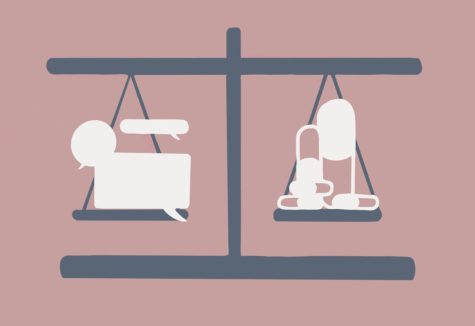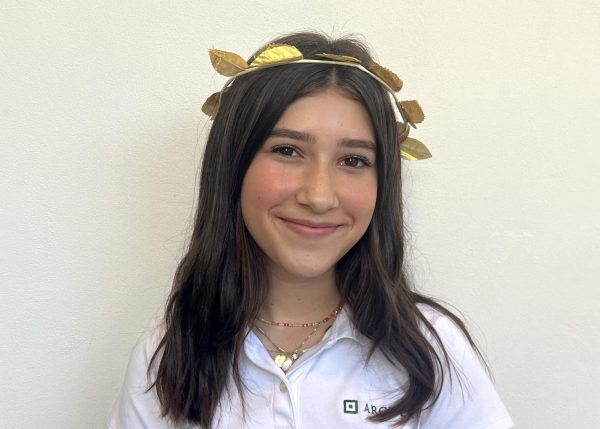Mental health professionals discuss complexities of antidepressants, ways to cope with mental disorders
Photo credit: Francie Wallack
Various medications spill out of a pill bottle. According to Harvard Health Publishing, antidepressants are one of the most common ways to treat many mental health disorders but they do not work very well without therapeutic support. “It [medication] treats the symptom, not the root of the issue” Licensed marriage and family therapist Natalie Kazarian said
April 10, 2023
A quick fix, a happy pill and an instant relief are common phrases used to describe antidepressants. But does this paint an accurate picture?
Antidepressants are a type of drug used to minimize and treat symptoms of anxiety, depression, major depressive disorder, obsessive compulsive disorder, post traumatic stress disorder, panic attacks and social anxiety disorder. The drugs target and correct neurotransmitters, carriers of chemical signals, in the brain. The federal government’s health statisticians found that about 1 in 1o Americans take antidepressants.
Misconceptions
There are many common misconceptions about what antidepressants are and what they do. Licensed marriage and family therapist Natalie Kazarian specializes in the treatment of anxiety, depression, developmental trauma and behavioral struggles in children. Kazarian frequently refers patients to psychiatrists so they can be prescribed antidepressants. She said her patients often enter the medicating process with misconceived ideas about medication, which can sometimes impact their experience with it.
“I can certainly understand the desire or the yearning for there to be a magic pill. But it just doesn’t work like that,” Kazarian said. “It treats the symptom, not the root of the issue”
Dr. Shirah Vollmer is a board certified child and adult psychiatrist who believes that medication is only a fraction of what makes a treatment plan successful.
“I always say that medication is about 10 or 20% of the treatment program,” Vollmer said. “A big part of the treatment program are lifestyle changes, and a big part of the treatment program is psychotherapy. It’s never ever just medication.”
Similar to Vollmer and Kazarian, board certified child and adolescent psychiatrist Zeb Little said he believes people cannot rely on medications to fix problems they may be facing.
“So much of our society is based on ‘just take a pill or do a thing and it’ll fix whatever problem you’re having,'” Little said. “That’s not really what it’s like to be a human being. That’s not really how life works.”
Stigmas
Historically, mental disorders and their treatment have been heavily stigmatized. Taking medication, in particular, is often associated with “weakness” and “laziness.” Little said that prior to starting medication, many of his patients enter the process with a negative outlook towards taking medication.
“Some people feel that it’s an act of weakness,” Little said. “Other people feel that they will be dependent on the medication. Other people feel that it’s somehow letting the medicine run their life.”

(Graphic illustration by: Francie Wallack)
An article from the Mayo Clinic wrote that stigmas surrounding the treatment of mental disorders are extremely dangerous because they can sometimes stop people from receiving care and treatment.
“Others’ judgments almost always stem from a lack of understanding, rather than information based on facts,” Mayo Clinic wrote. “Learning to accept your condition and recognize what you need to do to treat it, seeking support and helping educate others can make a big difference.”
Before she refers her patients to psychiatrists, Kazarian said she takes time with her patients to think about their relationship with medications and understand any preconceived notions they might have.
“I really try to educate people in addition to learn more about their belief systems around taking psychological meds.” Kazarian said.
Lifestyle changes and psychotherapy
In 2005, Dr. Mark Olfson, professor of clinical psychiatry at Columbia University, co-authored a survey that collected data on the number of people who took antidepressants and simultaneously received psychotherapy. The survey concluded one in five people taking antidepressants were receiving therapy as well. Scientists have found that the combination of medication and therapy are the most effective treatment method for various mental disorders, so Olfson said that those who do not attend psychotherapy are less likely to see positive results from the medication.
Kazarian agrees with Olfson and said she suggests her patients remain in therapy because she knows they will see the best results pairing the two treatments.
“I give them recommendations about how we still need to continue therapy weekly or biweekly, or however frequently, but ultimately, you know, it really is up to the patient,” Kazarian said. “Sometimes people actually do stop therapy once they start medication, so there’s not much I can do about that, nor can any clinician do about that. If somebody decides to stop they stop, but it’s not what I would recommend.”
Kazarian said that medication is a less personalized approach to the treatment of mental disorders, while more holistic approaches, such as therapeutic support, can be catered to a someones specific needs.
“My recommendation is that we have more collaboration between mental health professionals, doctors and naturopaths. We get Somatic experiences involved whether that be massage or acupuncture,” Kazraian said. We help people understand their diet and nutrition. And we understand how consumption of all media impacts the way that we feel.”
Prior to prescribing medications, Vollmer has an extensive process to assess whether or not medication is the right choice for her patient. If the patient is under 18, she spends three hours talking to the child and their parents. When the patient is above 18, it is a one-hour appointment. After this process, she closely monitors her patients to make sure they are stable and thriving.
“I’m talking to them about their lifestyles, about their relationships, about their jobs, about exercise and diet and sleep, and mindfulness and meditation and yoga,” Vollmer said. “I’m talking to them about all these things as I do [a] very, very close follow up. That’s how I ensure that it’s a more holistic approach.”
Inequities
The U.S Government Accountability Office reported that there are immense disparities in the accessibility to mental health and behavioral health care, specifically with lower income individuals and minority groups. This is, in part, due to the large cost of medication and therapy. Although the Affordable Care Act requires that insurance covers therapy fees, many therapists do not accept insurance. The cost of therapy without insurance ranges between $60-$250 per hour session, and the cost of antidepressants without insurance ranges from $11.22- $277.36.
Therapy sessions are generally weekly, bi weekly or monthly and prescriptions need to be refilled monthly. Verywell Mind conducted a survey in 2022 about the costs of therapy. It concluded that 48% of the respondents said they’d have to stop attending therapy if costs increase, 38% needed financial assistance to pay for their sessions and about one-third have reduced frequency or canceled therapy to save money.
Vollmer acknowledged an additional barrier to equitable health care: the shortage of mental health care providers.
“The inequities are huge, of course. They’re huge because there are very few psychiatrists,” Vollmer said. “There aren’t enough psychiatrists to treat the problems of the United States and the world, so it’s hard to find a provider. Providers also tend to clump in very affluent areas to get paid the most amount of money, so they don’t go to the areas of low income people. So low income people have terrible, terrible access to care.”
In 2019, there were 970 million people worldwide with diagnosed mental disorders, with depression and anxiety being the most prevalent. Little said because mental health disorders are universal to all people, it is important for society to unify and provide equal access to mental health care.
“The way our society restricts access to mental health care and reinforces social inequities through unfair financial and healthcare practices… it’s a terrible travesty,” Little said.
To hear to more about board certified child and adolescent psychiatrist Zeb Little’s opinions on the complexities of antidepressants, listen to the audio clip below.
Due to the high cost of professional mental health care is high, Kazarian said she believes there are ways to cope that don’t require therapy or medication. She posts tips and strategies for people to follow when they need some guidance on how they can cope. Similarly, Vollmer said there are many ways to care for yourself that are easy and free.
“Things like yoga for your body and your mind to kind of learn to breathe, and through your breath you learn relaxation, and you learn peacefulness in the moment,” Vollmer said. “And that’s for everybody, and all of that is free.”
Little said that whether paired with therapy and lifestyle changes or not, antidepressants can greatly improve many people’s lives. Little has seen the positive impacts of antidepressants on his patients, which is why he knows their impacts are real.
“It’s [medication] a very important tool in our toolbox to help people but, like any carpenter, if you’re only using a hammer, you’re not gonna get a very good house,” Little said. “So it really is about knowing how to use all the tools and helping people to learn to be their own craftsman of their products, and that sometimes involves medication, but it always involves other types of learning, and growing and skill building.




![Various medications spill out of a pill bottle. According to Harvard Health Publishing, antidepressants are one of the most common ways to treat many mental health disorders but they do not work very well without therapeutic support. "It [medication] treats the symptom, not the root of the issue" Licensed marriage and family therapist Natalie Kazarian said](https://archeroracle.org/wp-content/uploads/2023/03/MedicartionPhoto-900x600.jpg)





